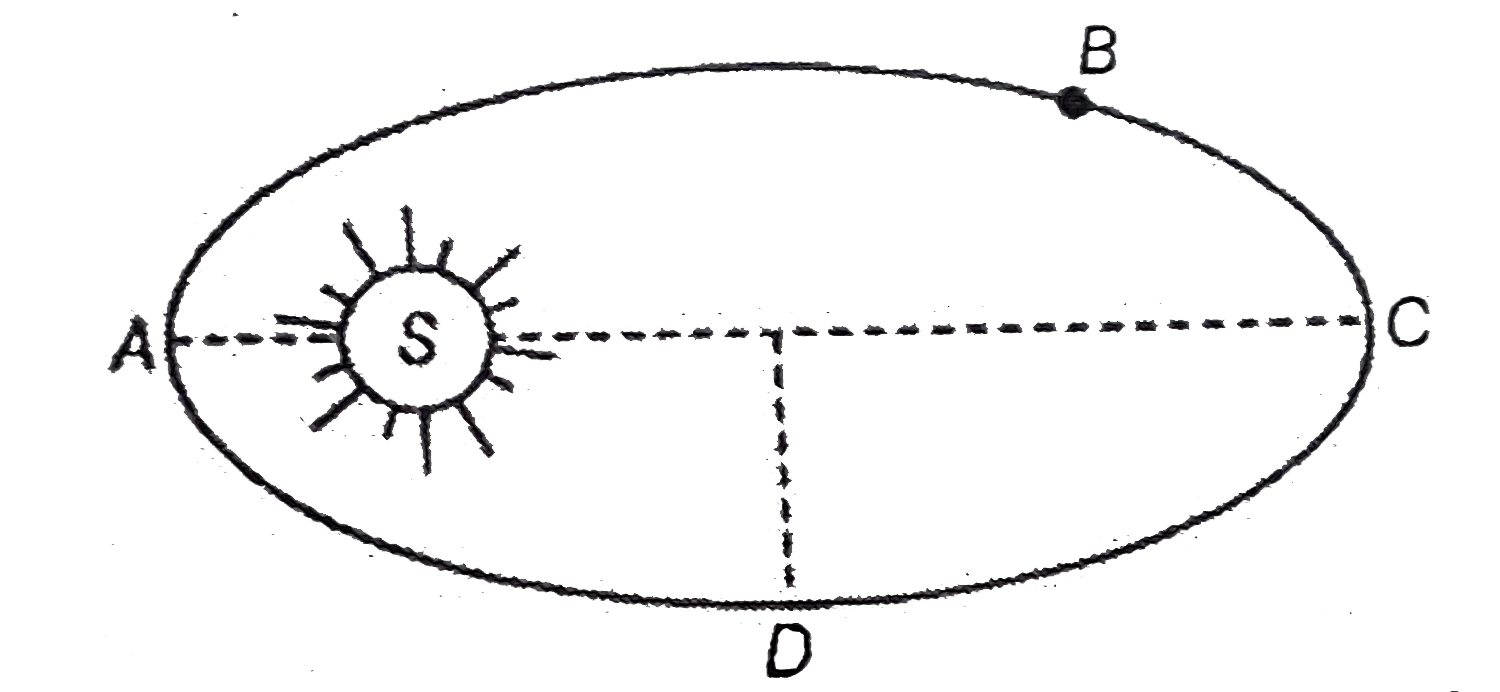A planet of mass m1 revolves round the sun of mass m2. The distance between the sun the planet is r. Considering the motion of the sun find the total energy of the system assuming the orbits to be circular.
The correct Answer is:A, B
To find the total energy of a system where a planet of mass m1 revolves around the sun of mass m2 at a distance r, we will consider both the kinetic energy and the gravitational potential energy of the system.
1. Identify the Forces Acting on the Planet:
The planet is in circular motion around the sun, which means there is a centripetal force acting on it. This centripetal force is provided by the gravitational force between the planet and the sun.
2. Write the Gravitational Force Equation:
The gravitational force Fg between the planet and the sun is given by:
Fg=Gm1m2r2
where G is the gravitational constant.
3. Write the Centripetal Force Equation:
The centripetal force Fc required to keep the planet moving in a circular path is given by:
Fc=m1v2r
where v is the orbital speed of the planet.
4. Set the Gravitational Force Equal to the Centripetal Force:
Since the gravitational force provides the necessary centripetal force, we can set the two equations equal to each other:
Gm1m2r2=m1v2r
5. Solve for the Orbital Speed v:
We can simplify the equation by canceling m1 (assuming m1≠0) and multiplying both sides by r:
Gm2r=v2
Therefore, we find:
v=√Gm2r
6. Calculate the Kinetic Energy KE:
The kinetic energy of the planet is given by:
KE=12m1v2
Substituting the expression for v2:
KE=12m1(Gm2r)=Gm1m22r
7. Calculate the Gravitational Potential Energy PE:
The gravitational potential energy of the system is given by:
PE=−Gm1m2r
(The negative sign indicates that the gravitational force is attractive.)
8. Calculate the Total Energy E:
The total energy of the system is the sum of the kinetic energy and the potential energy:
E=KE+PE=Gm1m22r−Gm1m2r
Simplifying this gives:
E=Gm1m22r−2Gm1m22r=−Gm1m22r
Final Result:
The total energy of the system is:
E=−Gm1m22r
The planet is in circular motion around the sun, which means there is a centripetal force acting on it. This centripetal force is provided by the gravitational force between the planet and the sun.
The gravitational force Fg between the planet and the sun is given by:
Fg=Gm1m2r2
where G is the gravitational constant.
The centripetal force Fc required to keep the planet moving in a circular path is given by:
Fc=m1v2r
where v is the orbital speed of the planet.
Since the gravitational force provides the necessary centripetal force, we can set the two equations equal to each other:
Gm1m2r2=m1v2r
We can simplify the equation by canceling m1 (assuming m1≠0) and multiplying both sides by r:
Gm2r=v2
Therefore, we find:
v=√Gm2r
The kinetic energy of the planet is given by:
KE=12m1v2
Substituting the expression for v2:
KE=12m1(Gm2r)=Gm1m22r
The gravitational potential energy of the system is given by:
PE=−Gm1m2r
(The negative sign indicates that the gravitational force is attractive.)
The total energy of the system is the sum of the kinetic energy and the potential energy:
E=KE+PE=Gm1m22r−Gm1m2r
Simplifying this gives:
E=Gm1m22r−2Gm1m22r=−Gm1m22r
The total energy of the system is:
E=−Gm1m22r
Topper's Solved these Questions
- GRAVITATIONBook:DC PANDEY ENGLISHChapter:GRAVITATIONExercise:Miscellaneous Examples
Explore 8 Videos
- GRAVITATIONBook:DC PANDEY ENGLISHChapter:GRAVITATIONExercise:Exercise 13.1
Explore 5 Videos
- GRAVITATIONBook:DC PANDEY ENGLISHChapter:GRAVITATIONExercise:(C) Chapter Exercises
Explore 45 Videos
- GENERAL PHYSICSBook:DC PANDEY ENGLISHChapter:GENERAL PHYSICSExercise:INTEGER_TYPE
Explore 2 Videos
- KINEMATICSBook:DC PANDEY ENGLISHChapter:KINEMATICSExercise:INTEGER_TYPE
Explore 10 Videos
Similar Questions
A planet is revolving round the sun in an elliptical orbit, If v is the velocity of the planet when its position vector from the sun is r, then areal velocity of the planet is
View SolutionFind the speeds of a planet of mass m in its perihelion and aphelion position. The semimajor axis of its orbit is a, eccentricity is e and the mass of the sun is M. Also find the total energy of the planet in terms of the given parameters.
View Solution
Knowledge Check
A planet revolves around the sun in an elliptical orbit. Suppose that the gravitational attraction between the sun and the planet suddenly disappear then the planet would move
Atowards the sun in a spiral pathBaway from the sun along a straight path with continuously increasing speedCwith constant speed along a tangential path to the oribtDtowards the sun along a straight path with constant speedA planet revolves in elliptical orbit around the sun. (see figure). The linear speed of the planet will be maximum at
 AABBCCDD
AABBCCDD
The distance of the planet Jupiter from the Sun is 5.2 times that of the Earth. Find the period of Jupiter's revolution around the Sun.
View SolutionA planet revolves in elliptical orbit around the sun. (see figure). The linear speed of the planet will be maximum at

View SolutionA planet of mass m revolves in elliptical orbit around the sun of mass M so that its maximum and minimum distance from the sun equal to ra and rp respectively. Find the angular momentum of this planet relative to the sun.
View SolutionA planet is revolving around the Sun in an elliptical orbit. Its closest distance from the Sun is r and farthest distance is R. If the orbital velocity of the planet closest to the Sun is v, then what is the velocity at the farthest point?
View SolutionA planet is revolving around the Sun in an elliptical orbit. Its closest distance from the sun is rmin. The farthest distance from the sun is rmax if the orbital angular velocity of the planet when it is nearest to the Sun ω then the orbital angular velocity at the point when it is at the farthest distance from the sun is
View SolutionThe time taken by Mars to revolve round the sun is 1.88 years. Find the ratio of average distance between mars and the sun to that between the earth and the sun.
View Solution